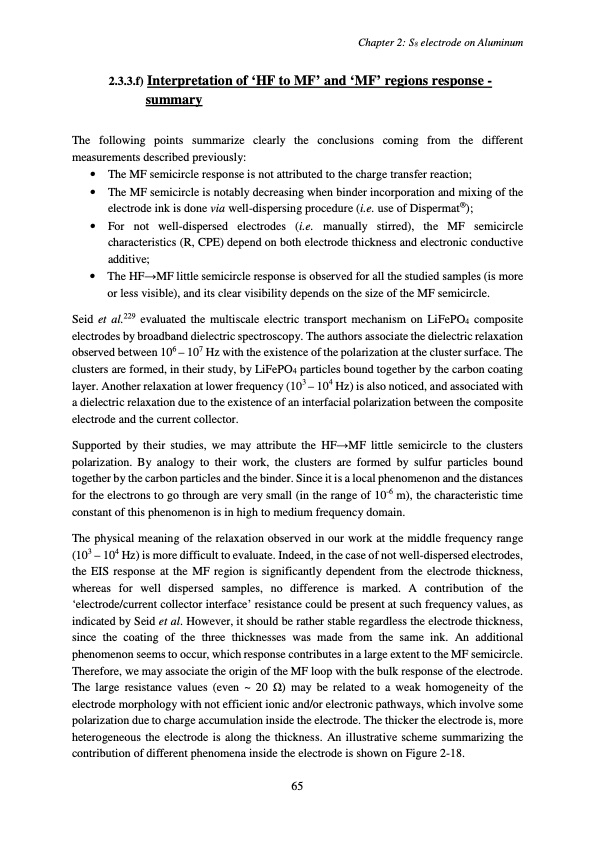
PDF Publication Title:
Text from PDF Page: 069
2.3.3.f) Interpretation of ‘HF to MF’ and ‘MF’ regions response - summary The following points summarize clearly the conclusions coming from the different measurements described previously: • The MF semicircle response is not attributed to the charge transfer reaction; • The MF semicircle is notably decreasing when binder incorporation and mixing of the electrode ink is done via well-dispersing procedure (i.e. use of Dispermat®); • For not well-dispersed electrodes (i.e. manually stirred), the MF semicircle characteristics (R, CPE) depend on both electrode thickness and electronic conductive additive; • The HF→MF little semicircle response is observed for all the studied samples (is more or less visible), and its clear visibility depends on the size of the MF semicircle. Seid et al.229 evaluated the multiscale electric transport mechanism on LiFePO4 composite electrodes by broadband dielectric spectroscopy. The authors associate the dielectric relaxation observed between 106 – 107 Hz with the existence of the polarization at the cluster surface. The clusters are formed, in their study, by LiFePO4 particles bound together by the carbon coating layer. Another relaxation at lower frequency (103 – 104 Hz) is also noticed, and associated with a dielectric relaxation due to the existence of an interfacial polarization between the composite electrode and the current collector. Supported by their studies, we may attribute the HF→MF little semicircle to the clusters polarization. By analogy to their work, the clusters are formed by sulfur particles bound together by the carbon particles and the binder. Since it is a local phenomenon and the distances for the electrons to go through are very small (in the range of 10-6 m), the characteristic time constant of this phenomenon is in high to medium frequency domain. The physical meaning of the relaxation observed in our work at the middle frequency range (103 – 104 Hz) is more difficult to evaluate. Indeed, in the case of not well-dispersed electrodes, the EIS response at the MF region is significantly dependent from the electrode thickness, whereas for well dispersed samples, no difference is marked. A contribution of the ‘electrode/current collector interface’ resistance could be present at such frequency values, as indicated by Seid et al. However, it should be rather stable regardless the electrode thickness, since the coating of the three thicknesses was made from the same ink. An additional phenomenon seems to occur, which response contributes in a large extent to the MF semicircle. Therefore, we may associate the origin of the MF loop with the bulk response of the electrode. The large resistance values (even ~ 20 Ω) may be related to a weak homogeneity of the electrode morphology with not efficient ionic and/or electronic pathways, which involve some polarization due to charge accumulation inside the electrode. The thicker the electrode is, more heterogeneous the electrode is along the thickness. An illustrative scheme summarizing the contribution of different phenomena inside the electrode is shown on Figure 2-18. Chapter 2: S8 electrode on Aluminum 65PDF Image | Accumulateur Lithium Soufre

PDF Search Title:
Accumulateur Lithium SoufreOriginal File Name Searched:
WALUS_2015_archivage.pdfDIY PDF Search: Google It | Yahoo | Bing
Sulfur Deposition on Carbon Nanofibers using Supercritical CO2 Sulfur Deposition on Carbon Nanofibers using Supercritical CO2. Gamma sulfur also known as mother of pearl sulfur and nacreous sulfur... More Info
CO2 Organic Rankine Cycle Experimenter Platform The supercritical CO2 phase change system is both a heat pump and organic rankine cycle which can be used for those purposes and as a supercritical extractor for advanced subcritical and supercritical extraction technology. Uses include producing nanoparticles, precious metal CO2 extraction, lithium battery recycling, and other applications... More Info
| CONTACT TEL: 608-238-6001 Email: greg@infinityturbine.com | RSS | AMP |